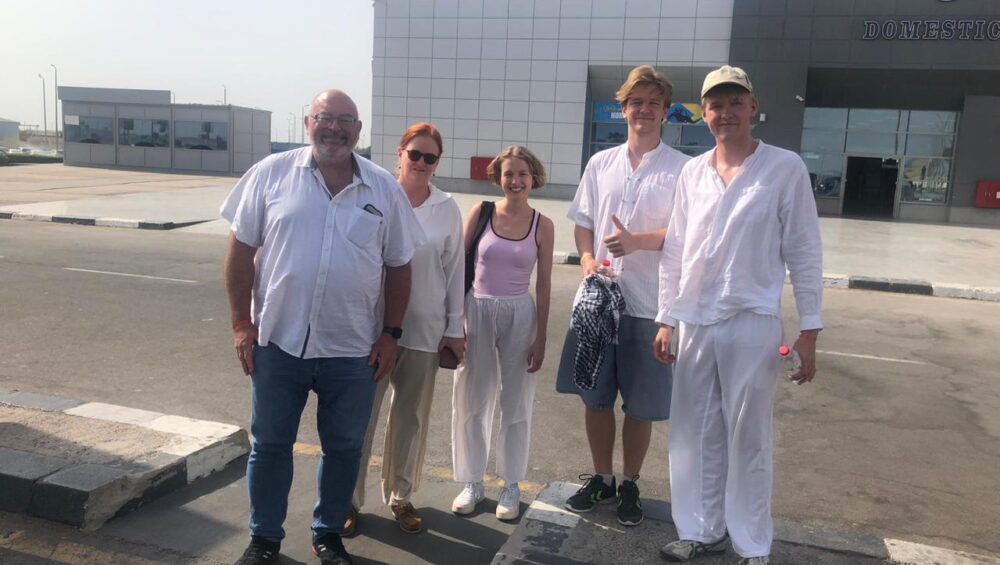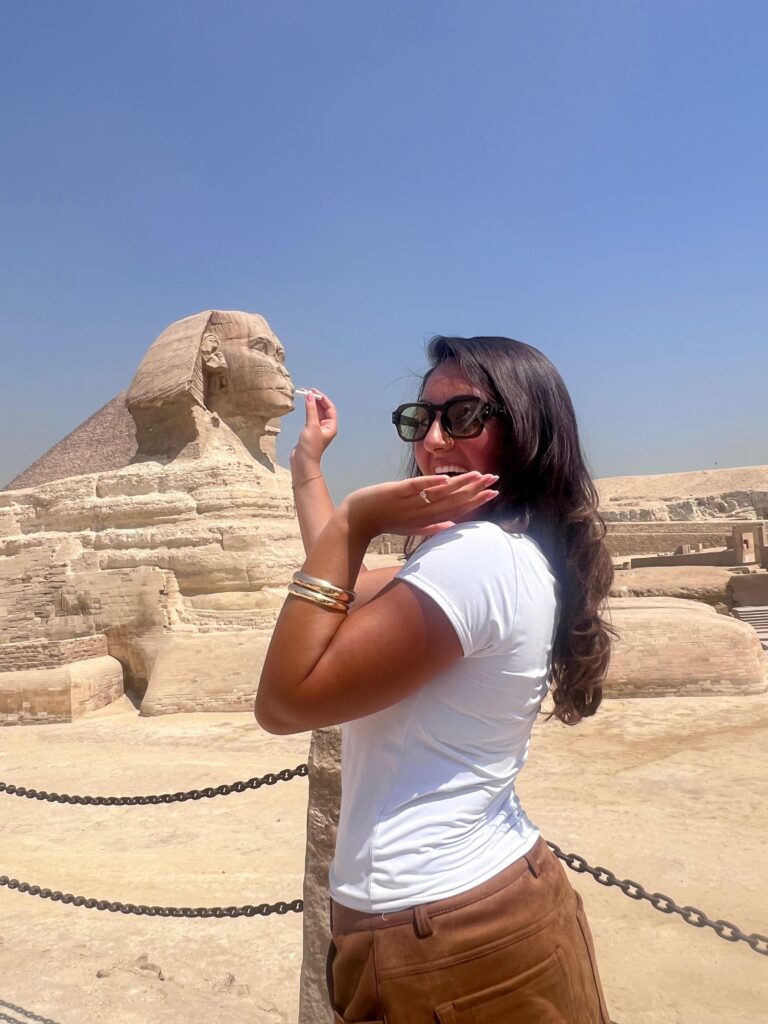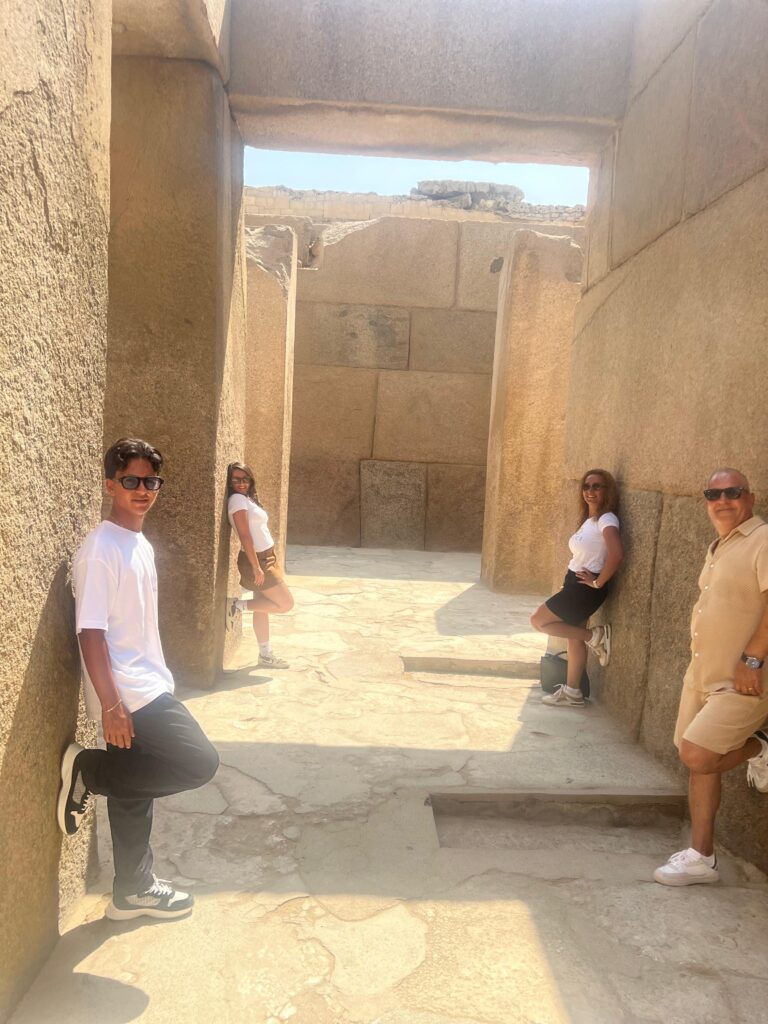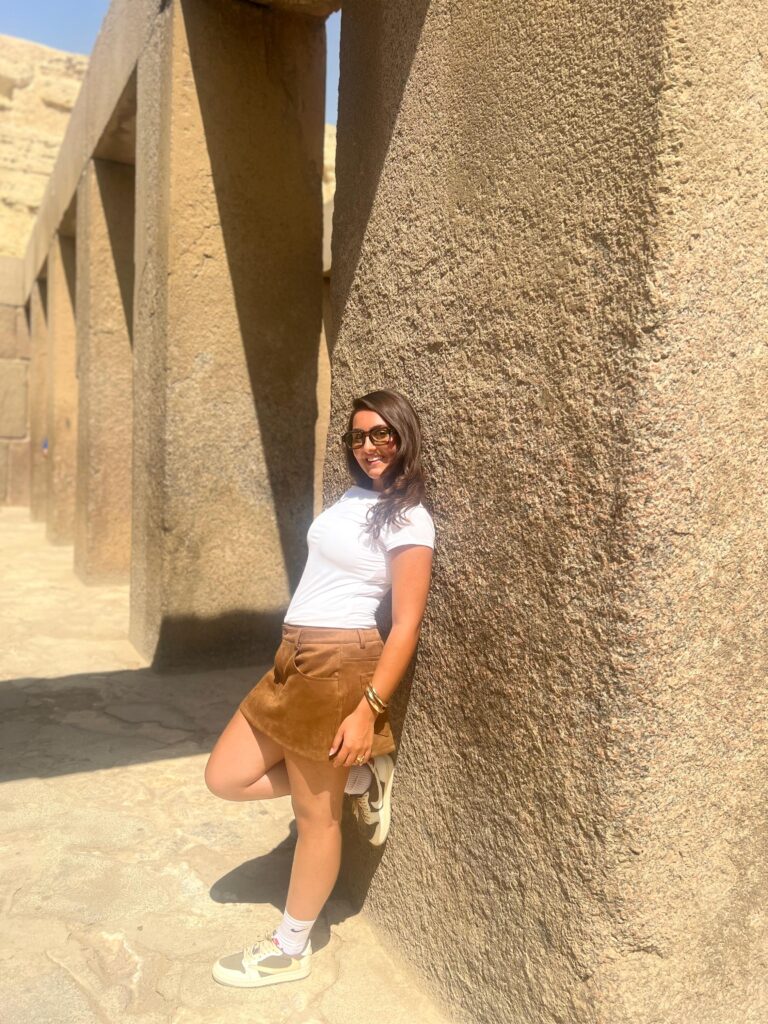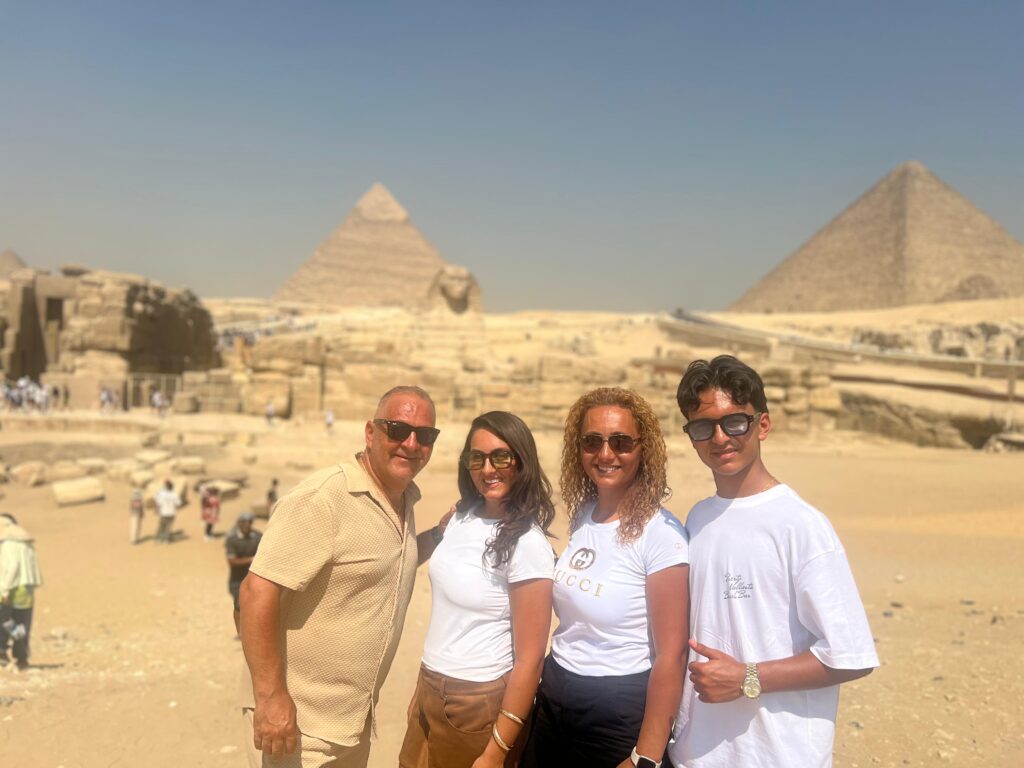Introduction to the Day Trip to Cairo from El Gouna by Plane
Travelers who come to the Red Sea town of El Gouna are usually drawn by its pristine beaches, crystal-clear waters, water sports, and luxurious resorts. However, no trip to Egypt is truly complete without visiting Cairo, the beating heart of Egyptian civilization. The day trip to Cairo from El Gouna by plane offers the perfect way to experience both worlds: you get to enjoy the modern leisure of the Red Sea while immersing yourself in the fascinating wonders of Pharaonic Egypt and the lively Egyptian capital.
This excursion is one of the most popular tours from El Gouna because it combines comfort, efficiency, and depth of exploration. Unlike long drives that can take 6–7 hours each way, the short flight from Hurghada to Cairo (just around 50 minutes) allows visitors to maximize their time in Cairo. With this advantage, travelers have a full day to discover Egypt’s greatest treasures — from the majestic Giza Pyramids and the mysterious Sphinx to the world-famous Egyptian Museum, bustling local bazaars, and the charm of the Nile.
Why Choose the Day Trip by Plane?
Time-Saving: The flight saves you 10–12 hours of road travel, giving you more time for sightseeing.
Comfort & Convenience: Air travel means you arrive fresh and ready to explore Cairo without exhaustion.
Comprehensive Experience: The tour covers Egypt’s most iconic landmarks in one day, with expert guidance.
Once-in-a-Lifetime Opportunity: Standing in front of the Great Pyramid of Khufu, sailing the Nile, or seeing Tutankhamun’s golden mask is a dream come true for many travelers.
By booking a day trip to Cairo from El Gouna by plane, you step beyond the sun and sea holidays of the Red Sea into the timeless story of one of the world’s greatest civilizations. The pyramids, the pharaohs, the treasures, the bustling city life — all become part of your personal Egyptian adventure.
The Journey Begins – Departure from El Gouna
Your exciting day trip to Cairo from El Gouna by plane starts early in the morning. The adventure is designed to maximize your time in Cairo while keeping the experience smooth and enjoyable.
Morning Pick-Up from Your Hotel in El Gouna
A representative or private driver will pick you up from your hotel in El Gouna in a comfortable, air-conditioned vehicle.
Pickup times vary depending on your flight schedule, but usually, it’s between 4:30 AM and 5:30 AM.
You will be transferred from El Gouna to Hurghada International Airport, which takes around 30–40 minutes.
Check-In and Boarding the Flight to Cairo
Upon arrival at the airport, your guide will assist you with check-in procedures.
Domestic flights from Hurghada to Cairo usually take 50–60 minutes.
The planes are modern, and the flight is smooth, giving you the chance to relax or even nap before your big adventure.
Arrival in Cairo – The First Impressions
Once you land at Cairo International Airport, you will be welcomed by your professional Egyptologist guide.
The excitement begins the moment you step out: Cairo, with its unique blend of modern high-rises, bustling streets, and echoes of thousands of years of history, greets you warmly.
The guide will provide an overview of the day’s itinerary, ensuring you know what to expect and are prepared to dive into history.
The Road Ahead in Cairo
From the airport, your guide and driver will take you directly to the first major highlight of your tour. Depending on the itinerary, you may head straight to Giza Plateau to see the pyramids and the Sphinx, or begin your journey at the Egyptian Museum in Tahrir Square.
Either way, the moment you arrive, you will realize that this is not just another tour — it’s a step back in time to the age of the Pharaohs, a chance to witness human history’s most extraordinary monuments.

The Flight Experience – From El Gouna to Cairo in Comfort and Style
One of the most defining features of a day trip to Cairo from El Gouna by plane is the sheer convenience it offers compared to other travel methods. While a journey by bus or private car can take anywhere from 5 to 7 hours one way, the flight from Hurghada International Airport (just a short drive from El Gouna) to Cairo International Airport takes approximately 50 minutes to 1 hour. This time-saving advantage means travelers can maximize their hours in Cairo exploring its world-famous treasures rather than sitting on the road.
The Morning Transfer from El Gouna
Your journey begins with an early morning hotel pick-up in El Gouna. Depending on your exact hotel location, the transfer to Hurghada International Airport takes roughly 30–40 minutes. Comfortable, air-conditioned vehicles are provided, ensuring you start your day in Cairo with ease. A friendly tour representative usually accompanies you to help with check-in and boarding formalities, making the process smooth and stress-free.
Boarding the Flight
Upon arrival at the airport, you’ll board a domestic flight operated by EgyptAir or another local carrier. These flights are short-haul but efficient, offering comfortable seating, light snacks, and attentive service. Many travelers are pleasantly surprised by the breathtaking view of the Red Sea coast, desert landscapes, and the fertile Nile Valley as the plane glides towards Cairo.
Flight duration: Around 50–60 minutes
Departure time: Early morning (typically between 5:00 AM – 7:00 AM)
Arrival in Cairo: Around 6:30 AM – 8:30 AM depending on schedule
By the time you land in Cairo, you’ll feel refreshed and ready for a full day of discovery.
Advantages of Flying Over Other Transport
Time-Saving – Arriving early in Cairo gives you almost a full day to enjoy the wonders of the city.
Comfortable Journey – Instead of spending long hours on Egypt’s highways, you enjoy a quick, scenic flight.
Energy Efficiency – Flying helps conserve your energy for exploring Cairo’s vast attractions such as the Pyramids, Sphinx, and the Egyptian Museum.
Safety and Reliability – Domestic flights are punctual, well-maintained, and operated by professional crews.
In essence, the flight is not just a mode of transport—it is an integral part of the luxurious and practical design of this day trip to Cairo from El Gouna by plane.
Arrival in Cairo – First Impressions of Egypt’s Capital
The moment your plane touches down in Cairo International Airport, you are stepping into one of the largest and most dynamic cities in the Middle East and Africa. Cairo, often referred to as “the City of a Thousand Minarets,” is a living museum where modernity collides with ancient history.
Meeting Your Egyptologist Guide
After landing, you will be greeted by a professional Egyptologist tour guide—a specialist in Egyptian history, archaeology, and culture. This personal guide is your key to unlocking the mysteries of Cairo and ensures your experience is not just sightseeing, but a true journey through history. They will accompany you throughout the day, providing fascinating explanations, answering questions, and ensuring your itinerary flows seamlessly.
The Drive into Cairo
From Cairo International Airport, your private, air-conditioned vehicle will take you into the heart of the city. The ride offers a fascinating first glimpse of life in Cairo:
Bustling traffic filled with cars, buses, and minibuses.
Tall buildings mixed with historical mosques and churches.
Street vendors selling everything from falafel to fresh sugarcane juice.
The vibrant energy of over 20 million people who call Cairo home.
It’s an introduction like no other, immersing you immediately into the unique pulse of Egypt’s capital.
First Stop – The Egyptian Museum
Most itineraries start with the Egyptian Museum in Tahrir Square, a treasure trove of antiquities and the perfect place to begin your exploration. The museum houses over 120,000 artifacts, including the glittering treasures of Tutankhamun, ancient statues, papyrus scrolls, and royal mummies. Walking through its halls is like stepping into the very soul of Ancient Egypt.
Highlights of this visit include:
The golden mask of King Tutankhamun.
Royal mummies of famous Pharaohs like Ramses II and Hatshepsut.
Ancient jewelry, pottery, and tools that illustrate everyday life in Pharaonic Egypt.
A Glimpse of Cairo’s Diversity
After visiting the museum, many tours also include a drive through downtown Cairo, offering a glimpse of the city’s colonial architecture, modern skyscrapers, and bustling neighborhoods. This blend of the old and new showcases Cairo as a city of contrasts—a place where ancient Pharaohs, Islamic dynasties, and modern Egyptians have each left their mark.
Preparing for the Giza Plateau
As the morning progresses, anticipation builds for the highlight of the day: the legendary Pyramids of Giza. Before arriving at this iconic landmark, your guide will provide background on the Pharaohs who built them and their symbolic importance in Egyptian civilization.
By this stage of the trip, you’ve experienced a smooth flight, a warm welcome in Cairo, and your first immersion into Egyptian history. The excitement for what’s to come only grows stronger.
The Grand Egyptian Museum – The Gateway to Ancient Wonders
The highlight of your day trip to Cairo from El Gouna by plane begins the moment you step foot into the much-anticipated Grand Egyptian Museum (GEM). Often described as the “world’s largest archaeological museum,” this masterpiece is more than just a collection of relics—it is a modern sanctuary built to honor and preserve the soul of Ancient Egypt.
As you arrive, the sheer grandeur of the building takes your breath away. With its futuristic architecture blending glass, steel, and stone, the museum is not just a container of history—it is history reborn for the modern traveler. Nestled near the Pyramids of Giza, the GEM is perfectly positioned, symbolizing a bridge between the modern city and the timeless world of the pharaohs.
Inside, your Egyptologist guide leads you through corridors filled with treasures that once defined the glory of Egypt. Over 100,000 artifacts are housed here, but what sets the museum apart is its thematic storytelling. Rather than presenting objects randomly, the GEM is carefully curated to walk you through Egypt’s historical timeline—from pre-dynastic times to the Greco-Roman era.
The Treasures of Tutankhamun
A highlight for most visitors is the complete collection of Tutankhamun’s treasures, displayed together for the first time since their discovery by Howard Carter in 1922. The boy king’s golden mask, his chariots, jewelry, weapons, and even his personal sandals are on display. As you gaze upon the glittering artifacts, you are instantly transported back to the moment of discovery, standing alongside Carter in awe of the untouched tomb.
Interactive Experience
The museum doesn’t just show artifacts—it immerses you in them. Through modern technology, 3D holograms, and interactive displays, you can “see” ancient craftsmen at work, watch reconstructed scenes of Egyptian life, and even experience a digital journey through the Nile Valley as it appeared thousands of years ago.
For many travelers, this part of the trip is a profound emotional moment. You came on a day trip from El Gouna to Cairo by plane, and suddenly, within just a few hours of leaving the Red Sea coast, you find yourself face-to-face with some of humanity’s most extraordinary achievements.
Before leaving the GEM, take a moment in the wide glass halls, where floor-to-ceiling windows provide stunning views of the Pyramids of Giza in the distance. The vision is symbolic—you are moving from the treasures of the pharaohs to their eternal resting places.
The Pyramids of Giza and the Great Sphinx – Wonders of the Ancient World
No day trip to Cairo from El Gouna by plane is complete without visiting the Pyramids of Giza, the last surviving Wonder of the Ancient World. As your tour vehicle approaches the Giza Plateau, the moment is unforgettable. The pyramids rise majestically against the horizon, their golden limestone blocks glowing in the desert sun.
Your guide begins to unfold the stories—of Khufu, Khafre, and Menkaure, the three pharaohs whose monumental pyramids stand side by side, defying time and gravity for over 4,500 years.
The Great Pyramid of Khufu
Standing at an original height of 146 meters, the Great Pyramid of Khufu is the crown jewel. Built with over 2.3 million stone blocks, each weighing up to 80 tons, it has long fascinated historians, engineers, and travelers alike. How was it built without modern machinery? Was it truly just manpower, or were there forgotten techniques? As you stand before it, the sheer size makes you realize why it was considered a miracle of engineering.
The Pyramid of Khafre and the Sphinx
The Pyramid of Khafre, slightly smaller but appearing taller due to its elevated base, still retains some of its original smooth casing stones at the top. Nearby, guarding the entire plateau, lies the Great Sphinx—a colossal limestone statue with the body of a lion and the face of a pharaoh, believed to represent Khafre himself.
Standing before the Sphinx, you feel both awe and mystery. The statue has endured wars, storms, and centuries of erosion, yet it still gazes silently across the desert, as if keeping the secrets of the pyramids hidden forever.
Optional Adventures
During your guided visit, you may choose to:
Enter the Great Pyramid: A once-in-a-lifetime chance to climb inside narrow passageways leading to the King’s Chamber.
Ride a Camel: Experience the timeless image of crossing the sands of Giza atop a camel, with the pyramids in the background.
Photography Moments: Your guide knows the best panoramic spots where all three pyramids align, giving you that perfect picture to remember your journey.
The Spiritual Experience
For many travelers, visiting the Pyramids of Giza is more than just sightseeing—it’s a deeply spiritual encounter. Standing on the plateau, surrounded by structures that have defied time, you feel connected not only to Egypt’s past but to the very essence of human civilization.
As your guide explains the symbolism of the pyramids—their alignment with the stars, their representation of rebirth, and their role as stairways to the afterlife—you realize why they continue to inspire millions around the world.
By now, your day trip from El Gouna to Cairo by flight has already given you memories that will last a lifetime—but the adventure is far from over. Ahead lies a delicious lunch overlooking the pyramids, and a visit to the vibrant bazaars of Cairo, where the city’s living culture complements its ancient heritage.
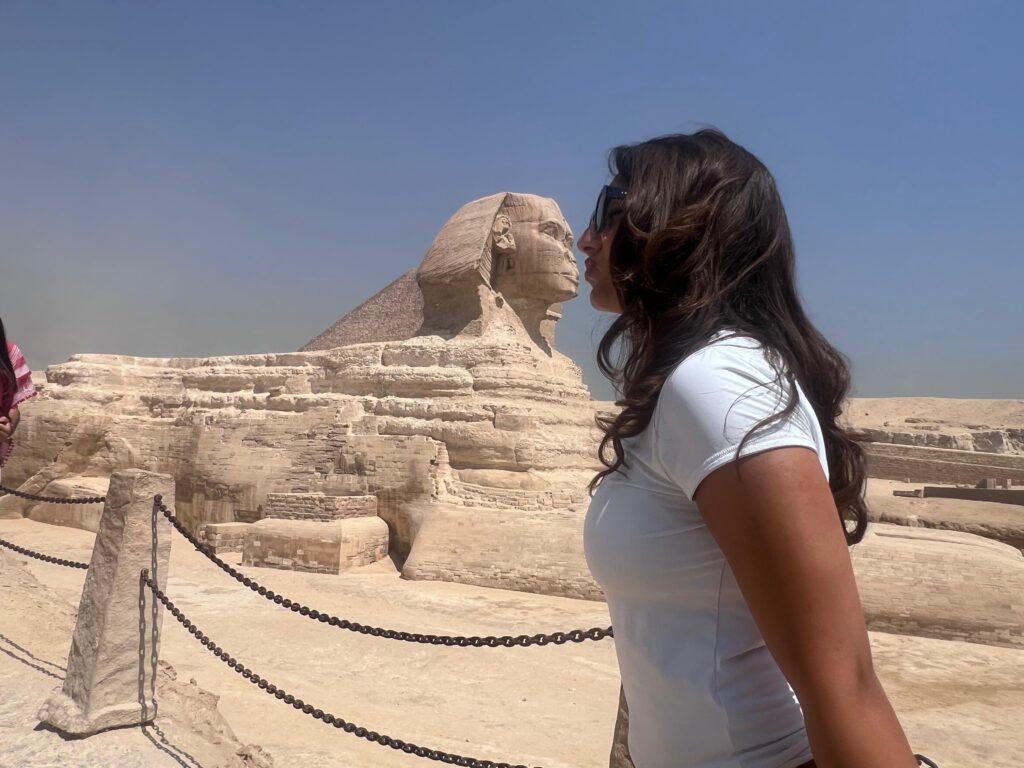
Cairo’s Timeless Charm – The Egyptian Museum of Antiquities
No journey to Cairo is complete without stepping into the Egyptian Museum of Antiquities, a living chronicle of over 5,000 years of Egyptian civilization. After leaving the Pyramids and Sphinx, many day tours from El Gouna by plane naturally guide visitors into this sanctuary of treasures, allowing you to encounter the glory of ancient Egypt in its most intimate form.
A Treasure House Beyond Imagination
The Egyptian Museum, often called the “guardian of pharaonic legacy”, holds more than 120,000 artifacts—from the smallest amulets to towering statues of pharaohs. Imagine walking through corridors where mummies rest in their eternal sleep, golden masks glisten under soft lights, and monumental sarcophagi tell stories of kings and queens who shaped human history.
For many travelers, the highlight is the Tutankhamun collection, discovered in 1922 by Howard Carter. The sight of the boy king’s golden mask is enough to leave anyone speechless. You are not just looking at a relic—you are staring at the face of a king who ruled Egypt over 3,000 years ago.
Highlights Not to Miss
Royal Mummies Hall – where preserved bodies of Ramses II, Seti I, and Queen Hatshepsut reveal the extraordinary embalming techniques of the ancients.
The Treasures of Tanis – often overshadowed by Tutankhamun’s artifacts, this collection is equally dazzling with golden jewelry, silver coffins, and intricate funerary masks.
Statues of Khafre and Menkaure – the same kings who built the Pyramids you visited earlier now stand before you in sculpted perfection.
Everyday Life Exhibits – pottery, tools, papyrus scrolls, and jewelry that give you a glimpse into how ordinary Egyptians lived thousands of years ago.
The Emotional Impact
Inside the museum, time ceases to exist. The air carries a subtle sense of reverence, as if the ancient souls themselves linger among the exhibits. For visitors flying in from El Gouna, this moment often becomes the highlight of the trip. To stand inches away from artifacts you’ve only read about in history books is a privilege unlike any other.
It’s not just a museum visit—it’s a dialogue with eternity.
Lunch with a View – Dining by the Pyramids
After immersing yourself in the museum’s wonders, your senses will crave rest and nourishment. What better way to pause than with a traditional Egyptian lunch overlooking the Pyramids of Giza?
A Culinary Pause in the Midst of History
Your guide will often take you to a carefully chosen restaurant with panoramic views of the Pyramids. As you sit at your table, sipping on a refreshing drink, you realize that few dining experiences in the world can compare—a meal in the shadow of the only remaining wonder of the ancient world.
What’s on the Menu?
Egyptian cuisine is as rich as its history, blending Middle Eastern, Mediterranean, and North African influences. Expect to find:
Grilled kofta and kebabs served with aromatic spices.
Molokhia (a traditional green soup with herbs) paired with rice.
Mahshi – vegetables stuffed with seasoned rice.
Freshly baked pita bread served with tahini, baba ghanoush, and hummus.
A selection of fresh fruits and oriental desserts like basbousa and konafa.
For vegetarians, there are always plenty of options—Egyptian cuisine is naturally rich in vegetable-based dishes.
The Atmosphere
As you enjoy your meal, take a moment to look out at the grandeur of the pyramids. Camels trot slowly in the distance, tourists marvel at the scenery, and the golden desert stretches endlessly. It’s not just lunch—it’s a spiritual pause, where food, culture, and history merge into one unforgettable moment.
Many travelers describe this lunch as a dreamlike experience, where the line between past and present blurs. You eat, laugh, and relax under the gaze of structures that have outlived empires.
The Timeless Legacy of the Egyptian Museum
One of the absolute highlights of your day trip to Cairo from El Gouna by plane is the visit to the legendary Egyptian Museum, a treasure trove of ancient history. This museum, located in Tahrir Square in the heart of Cairo, is not just a building filled with artifacts—it is a living archive of over 7,000 years of Egyptian civilization.
Stepping into the Egyptian Museum is like stepping into another dimension of time. The atmosphere carries with it a sense of reverence, as if the walls themselves whisper the stories of pharaohs, priests, queens, and commoners whose lives shaped one of the greatest civilizations the world has ever known.
A Home for the Pharaohs
The museum houses over 120,000 artifacts, and while not all are on display at once, the selection you encounter on your Cairo day trip is beyond impressive. Each exhibit is meticulously arranged to transport you to different dynasties and eras of Egypt’s history—from the Pre-Dynastic Period to the Greco-Roman times.
Perhaps the most iconic attraction is the Tutankhamun collection. The boy king, who ruled during the 18th Dynasty, continues to fascinate the world thanks to his intact tomb discovered by Howard Carter in 1922. His golden funerary mask, weighing over 10 kilograms of pure gold, is the highlight of the collection. Standing in front of it, many visitors are moved to silence, realizing they are in the presence of one of humanity’s most exquisite treasures.
But Tutankhamun is just the beginning. The Egyptian Museum also contains monumental statues of pharaohs, intricate jewelry, delicate papyrus scrolls, and even mummified animals, including crocodiles, cats, and baboons, all of which the ancient Egyptians revered.
Why the Egyptian Museum is Essential on a Cairo Day Trip
When you take your El Gouna to Cairo day trip by plane, your guide ensures you explore the museum’s key highlights without feeling overwhelmed. With thousands of rooms and halls, it would take weeks to study everything in depth. Your Egyptologist guide carefully curates the experience, ensuring you witness the most important and impressive pieces.
This visit gives you a deeper context for the Pyramids and Sphinx. By observing real tools, writings, and everyday items from ancient Egypt, you gain insights into how the Pyramids were built, how the pharaohs lived, and why religion and the afterlife were at the heart of everything Egyptians did.
A Bridge to the Grand Egyptian Museum (GEM)
The current Egyptian Museum in Tahrir Square remains iconic, but much of its collection is gradually being transferred to the Grand Egyptian Museum (GEM) near the Pyramids. Depending on the timing of your day trip from El Gouna to Cairo, your itinerary may include a visit to the GEM instead—or in some cases, both museums.
The GEM is the largest archaeological museum in the world and promises an even more breathtaking experience, with state-of-the-art displays and interactive storytelling. This modern facility is designed to preserve Egypt’s treasures for future generations while offering visitors a spectacular journey through history.
Whether you visit the classic Egyptian Museum or the new GEM, this chapter of your Cairo adventure is unforgettable. It’s not just about seeing ancient objects—it’s about connecting to a civilization that forever changed humanity.

Traditional Egyptian Lunch with Pyramid Views
After an exhilarating morning exploring the Pyramids, the Sphinx, and the Egyptian Museum, it’s time for a well-deserved break. And what better way to relax than by enjoying a delicious traditional Egyptian lunch with a breathtaking view of the Pyramids themselves?
The Experience of Dining by the Pyramids
Imagine sitting in a cozy open-air restaurant with the majestic Great Pyramid of Khufu towering in the background. The air is filled with the aroma of freshly baked bread, grilled meats, and traditional Egyptian spices. As you sip on a refreshing drink, you realize you are experiencing something extraordinary: a meal with one of the Seven Wonders of the Ancient World as your backdrop.
This moment is more than just lunch—it is an immersion into Egyptian hospitality and culture. Egyptians take great pride in their food, which blends Middle Eastern, Mediterranean, and North African flavors into unique and hearty dishes.
Typical Egyptian Dishes You May Enjoy
The buffet usually includes a wide variety of Egyptian and international cuisine to suit all tastes. Some dishes you may encounter include:
Kofta (grilled minced meat skewers): Juicy, spiced meat grilled to perfection.
Chicken or beef shawarma: Tender slices of meat wrapped in fresh pita bread.
Koshari: Egypt’s national dish, a hearty mix of rice, pasta, lentils, chickpeas, and fried onions topped with spicy tomato sauce.
Molokhia: A green soup made from finely chopped jute leaves, often served with rice and chicken.
Freshly baked baladi bread: A staple of every Egyptian meal.
Hummus, baba ghanoush, and tahini: Creamy dips made from chickpeas, eggplants, and sesame paste.
Seasonal salads and pickles to refresh your palate.
Of course, no Egyptian meal is complete without sweet treats. You might enjoy baklava, basbousa (semolina cake soaked in syrup), or kunafa (a shredded pastry with cream or cheese filling).
Why Lunch Matters on Your Day Trip
By this point in your day trip from El Gouna to Cairo by flight, you will have walked extensively around the Pyramids and explored countless museum halls. This hearty lunch allows you to recharge, reflect on what you’ve seen, and prepare for the rest of the day’s adventures.
The restaurant setting also gives you a chance to take in the beauty of the Giza Plateau in a more relaxed way. As you sit back and enjoy your meal, the sight of the pyramids on the horizon becomes even more magical—almost surreal.
The Hospitality of Egypt
Egyptian hosts are known for their warmth and generosity. Expect your waiters to treat you not just as a tourist but as a guest of honor. Many visitors recall this meal as one of the highlights of their trip, not only because of the food but because of the hospitality and friendliness that make Egypt such a welcoming country.
Visiting the Egyptian Museum – A Journey Through Millennia
No day trip to Cairo from El Gouna by plane would be complete without stepping inside one of the greatest treasures of human civilization – The Egyptian Museum. After exploring the grandeur of the pyramids, your Egyptologist guide will lead you into this world-famous museum, located at the heart of Cairo’s bustling Tahrir Square.
The Legacy of the Museum
The Egyptian Museum, also known as the Museum of Egyptian Antiquities, holds the largest collection of Pharaonic artifacts in the world, with more than 120,000 items displayed. Built in 1902, the pink neoclassical building itself is a historical landmark, having witnessed revolutions, discoveries, and countless visitors seeking to understand Egypt’s glorious past.
The Tutankhamun Treasures
The highlight of your visit is undoubtedly the Tutankhamun Gallery. When Howard Carter discovered the boy king’s tomb in the Valley of the Kings in 1922, the world was mesmerized. Today, you can see the famous golden mask, jeweled coffins, and over 5,000 artifacts that tell the story of Tutankhamun’s short but legendary reign. Standing before these objects, you will feel transported back to 3,000 years ago, when Egypt ruled as the most advanced civilization on earth.
Other Masterpieces to See
Mummies Room (optional extra ticket): Where some of Egypt’s greatest pharaohs, including Ramses II and Hatshepsut, rest in eternal preservation.
Akhenaten Collection: Featuring stunning statues of the revolutionary king who changed Egypt’s religion.
Everyday Life in Ancient Egypt: Exhibits of jewelry, papyrus scrolls, and tools that reveal how ordinary Egyptians once lived.
Your guide will ensure you don’t miss the most important highlights during your limited time. This part of the tour adds depth to your journey, making you appreciate not only the monuments of Cairo but also the stories behind the stones.
Lunch with a Pyramid View – A Taste of Egypt
After a morning filled with sightseeing and cultural discovery, it’s time to relax and enjoy a well-deserved meal. One of the great highlights of this day trip to Cairo from El Gouna by plane is the opportunity to have lunch at a traditional Egyptian restaurant with a direct view of the Pyramids of Giza.
A Feast for the Senses
Imagine sitting on a shaded terrace, the mighty pyramids in the distance, while delicious plates of authentic Egyptian food are served before you. This isn’t just a lunch—it’s an experience that ties history, culture, and hospitality into one unforgettable moment.
Typical Dishes You Might Enjoy
Freshly baked baladi bread served with tahini and hummus.
Koshari – Egypt’s national dish made of rice, pasta, lentils, and spicy tomato sauce.
Grilled chicken or kofta (meat skewers) with Egyptian spices.
Stuffed vine leaves and falafel for vegetarian travelers.
A sweet ending with baklava or basbousa, paired with refreshing hibiscus tea or Egyptian mint tea.
The Atmosphere
The setting is calm and welcoming, offering travelers a chance to recharge. Whether you’re sitting with family, friends, or new companions you met during the tour, the restaurant creates the perfect opportunity to reflect on the wonders you’ve seen so far. The backdrop of the pyramids makes every bite taste even more magical.
Why Lunch is Essential in Your Cairo Day Trip
Exploring Cairo is an adventure, and energy is key. This stop ensures you feel refreshed and ready for the afternoon visits, while also immersing yourself in the culinary side of Egyptian culture.
Cairo’s Bustling Bazaars – Shopping Like a Local
No journey to Cairo is complete without experiencing its vibrant markets, and your day trip from El Gouna to Cairo by plane gives you the perfect chance to wander through these cultural gems. The most famous is Khan El Khalili Bazaar, a marketplace that has existed since the 14th century.
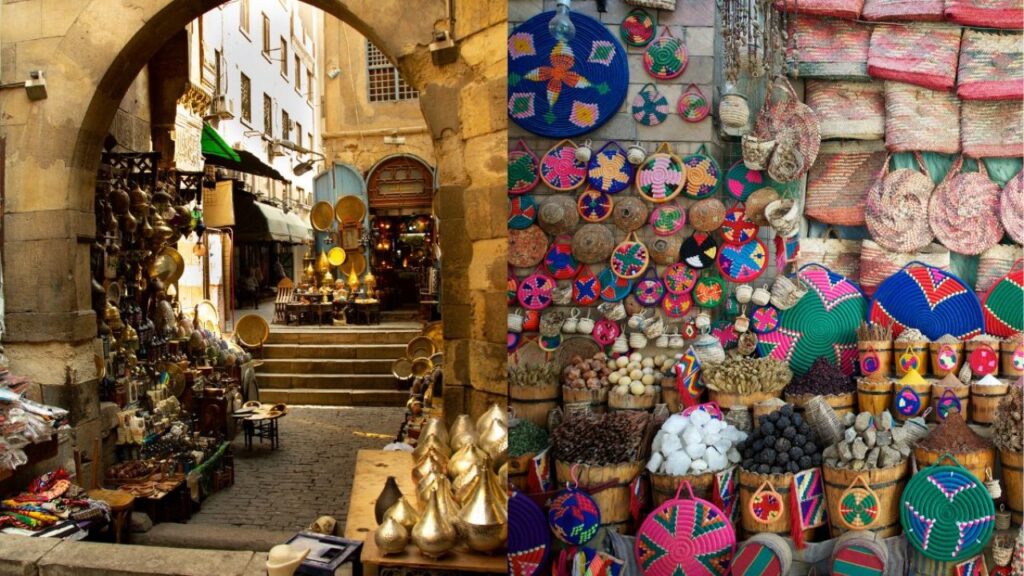
The Atmosphere of the Bazaar
As soon as you step into Khan El Khalili, you are transported to another world. The narrow alleyways are filled with the aroma of exotic spices, the glimmer of gold jewelry, and the colorful textiles hanging from every shopfront. The sounds of vendors calling out their prices, musicians playing traditional instruments, and the laughter of shoppers create an atmosphere unlike any other.
What to Buy
Perfumes & Oils: Cairo is famous for its natural essences. Vendors will let you sample fragrances made from jasmine, lotus, and sandalwood.
Papyrus Paintings: Hand-painted artworks on papyrus paper depicting scenes of Ancient Egypt make perfect souvenirs.
Spices & Herbs: From saffron to hibiscus tea, Cairo’s spice markets are a paradise for food lovers.
Handcrafted Jewelry: Silver and gold pieces, often designed with Egyptian motifs, are among the most sought-after items.
Traditional Lanterns (Fanoos): Beautifully crafted metal lanterns with stained glass windows, perfect for a keepsake of Cairo’s charm.
Insider Tips for Shopping
Bargaining is expected – Don’t accept the first price offered. Polite negotiation is part of the shopping culture.
Bring cash – Many small shops don’t accept cards, and cash will often help you get a better deal.
Take your time – Wandering slowly lets you enjoy the beauty and history of the market itself.
Visiting Khan El Khalili is not just about shopping—it is about connecting with Cairo’s heartbeat, witnessing centuries of trade, and embracing the lively energy of the Egyptian capital.
The Egyptian Museum – A Journey Through Millennia
After exploring the markets, your day trip to Cairo from El Gouna by plane takes you into the heart of history at the Egyptian Museum, one of the most important museums in the world.
A Treasure House of Civilization
Located in Tahrir Square, the Egyptian Museum houses more than 120,000 artifacts, spanning over 5,000 years of history. This is where the story of Ancient Egypt comes alive.
Highlights of the Museum
The Treasures of Tutankhamun: The legendary boy king’s golden mask, jewelry, and burial treasures are displayed here. The sheer craftsmanship and splendor of these objects leave visitors speechless.
Mummies of Pharaohs: Several royal mummies, including Ramses II and Hatshepsut, are preserved and on display, offering a direct connection to Egypt’s rulers of the past.
Statues and Sarcophagi: Colossal statues, intricately decorated coffins, and temple relics fill the museum halls, each telling a part of Egypt’s grand narrative.
Everyday Objects: Beyond royal treasures, the museum also exhibits tools, clothing, and artifacts used in daily life thousands of years ago, showcasing the sophistication of Ancient Egyptian society.
Why the Egyptian Museum is a Must-Visit
Visiting the Egyptian Museum is like walking through a time capsule. For travelers on a tight schedule, like those on a one-day trip from El Gouna to Cairo, it is a priceless opportunity to see the most significant collection of Ancient Egyptian history in one place.
Future of the Collections – The GEM
Some artifacts are gradually being transferred to the Grand Egyptian Museum (GEM) near the Pyramids of Giza, set to be the largest archaeological museum in the world. Still, the Egyptian Museum in Tahrir Square remains an essential stop for those wishing to immerse themselves in Egypt’s timeless heritage.
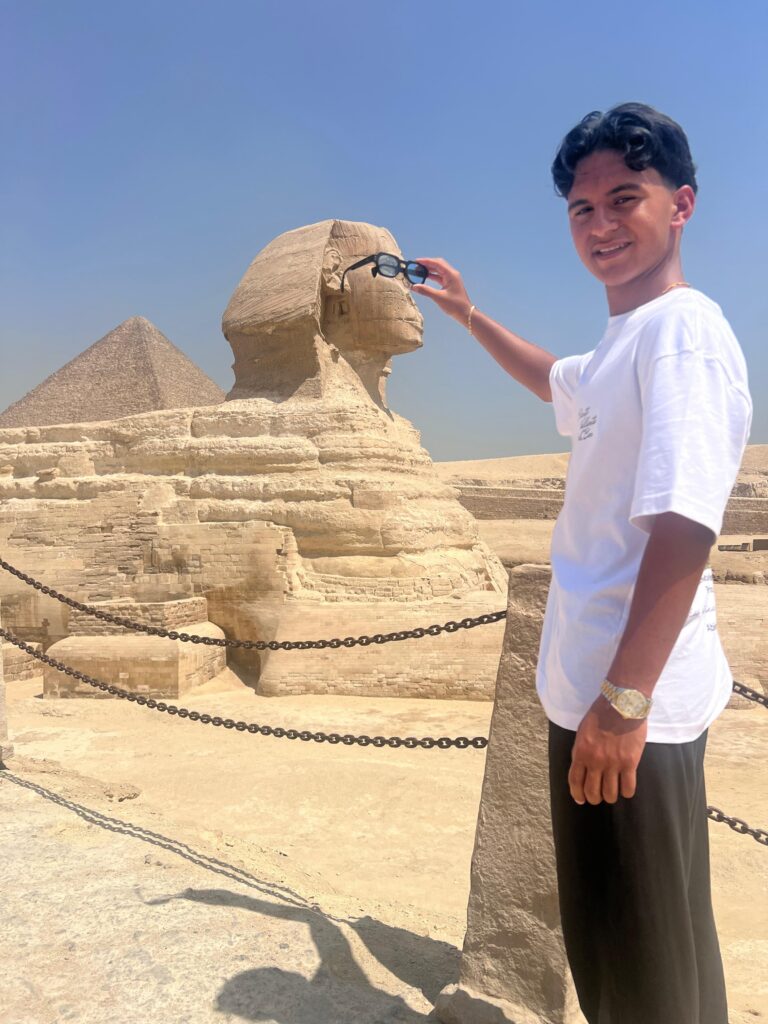
The Grand Egyptian Museum – A Gateway to Ancient Wonders
No day trip to Cairo from El Gouna by plane would be complete without a visit to the Grand Egyptian Museum (GEM), one of the most ambitious cultural projects in the world. Located just outside Giza, near the pyramids, the GEM is designed to be the world’s largest archaeological museum. It represents a bridge between the modern world and ancient Egypt, offering travelers a rare opportunity to see artifacts that have never before been displayed.
Why GEM Is a Must-Visit
Tutankhamun’s Collection: For the first time in history, the complete treasures of King Tutankhamun are displayed in one place. From golden masks to chariots, jewelry, and ceremonial items, this collection alone is worth the trip.
Architectural Marvel: The building itself is a wonder, blending modern glass and stone with design elements inspired by pharaonic geometry. It feels like stepping into a futuristic temple of knowledge.
Family-Friendly Design: Interactive exhibits, modern displays, and even virtual reality installations make the GEM suitable for travelers of all ages.
Proximity to the Pyramids: After visiting the GEM, you’re just minutes away from stepping into the desert plateau where the ancient pyramids rise.
Travelers arriving from El Gouna by plane usually start their Cairo journey here, as it sets the perfect tone for understanding the depth of Egypt’s history before heading to the pyramids.
Lunch with a View – Dining by the Pyramids
Exploring Cairo’s cultural wonders is thrilling but also energy-consuming. That’s why your day trip from El Gouna to Cairo by plane often includes a carefully planned lunch stop at a restaurant overlooking the pyramids. Imagine sitting at a table with the majestic Giza Plateau as your backdrop — a dining experience that blends cuisine and culture in an unforgettable way.
Culinary Highlights
Traditional Egyptian Dishes: Many restaurants serve authentic Egyptian meals such as kofta, shawarma, stuffed vine leaves, and koshari — the national dish of Egypt made of pasta, rice, lentils, and tomato sauce.
Fresh Salads & Mezze: Expect plates of tahini, baba ghanoush, hummus, and tabbouleh to start your meal.
Grilled Meats & Seafood: Cairo’s restaurants offer a variety of grilled chicken, lamb, or fresh fish, paired with rice and vegetables.
Desserts: Sweet tooth travelers can enjoy baklava, basbousa (semolina cake with syrup), or umm ali (Egypt’s version of bread pudding).
Refreshing Drinks: Alongside the meal, you’ll savor fresh juices like hibiscus, mango, or sugarcane.
Why This Stop Is Special
Scenic Views: Dining while gazing at the pyramids connects you to thousands of years of history. It’s not just food — it’s an experience.
Comfortable Break: After walking through museums and desert sites, a shaded, air-conditioned restaurant with panoramic views offers the perfect rest.
Cultural Immersion: Sharing a meal in Egypt is part of experiencing its hospitality, generosity, and traditions.
By this stage of the day trip, travelers feel recharged and deeply connected to the magic of Cairo, ready to continue exploring before the flight back to El Gouna.
The Egyptian Museum — A Journey Through Time
Stepping into the Egyptian Museum in Cairo is like entering a treasure chest of human civilization. For visitors on a day trip to Cairo from El Gouna by plane, this moment is often one of the highlights of the entire journey.
The museum, located in Tahrir Square, houses the world’s most extensive collection of ancient Egyptian artifacts — more than 120,000 items spanning over 5,000 years of history. As you walk through its grand halls, you are immediately transported into the world of pharaohs, priests, artisans, and everyday people who shaped the ancient civilization.
Tutankhamun’s Golden Legacy
Perhaps the most famous attraction in the museum is the golden treasure of King Tutankhamun. Discovered by Howard Carter in 1922 in the Valley of the Kings, these artifacts stunned the world with their sheer beauty and craftsmanship. The golden death mask, inlaid with lapis lazuli and turquoise, is one of the most iconic symbols of Ancient Egypt. Standing before it, travelers from El Gouna often describe feeling goosebumps — it is not just a piece of art, but a window into eternity.
Mummies and Their Secrets
The Royal Mummy Room offers another breathtaking experience. Here, you come face-to-face with some of Egypt’s most powerful rulers, including Ramses II and Hatshepsut. Preserved for millennia, these figures lie silently, yet their presence is overwhelming. Guides carefully explain the embalming process, beliefs about the afterlife, and how these kings once ruled with unimaginable power.
A Walk Through Daily Life
Beyond pharaohs and gold, the museum also offers artifacts from daily life: pottery, jewelry, tools, and papyrus documents. These displays allow you to imagine how ordinary Egyptians lived — their meals, their work, their beliefs, and even their games.
A Time Traveler’s Experience
For those coming from the tranquil beaches of El Gouna, the museum represents a dramatic shift — from the calm Red Sea to the vibrant heartbeat of Egypt’s history. It is often described as the bridge between modern Egypt and its eternal past, and for many visitors, it becomes a deeply emotional and unforgettable part of their Cairo day trip.
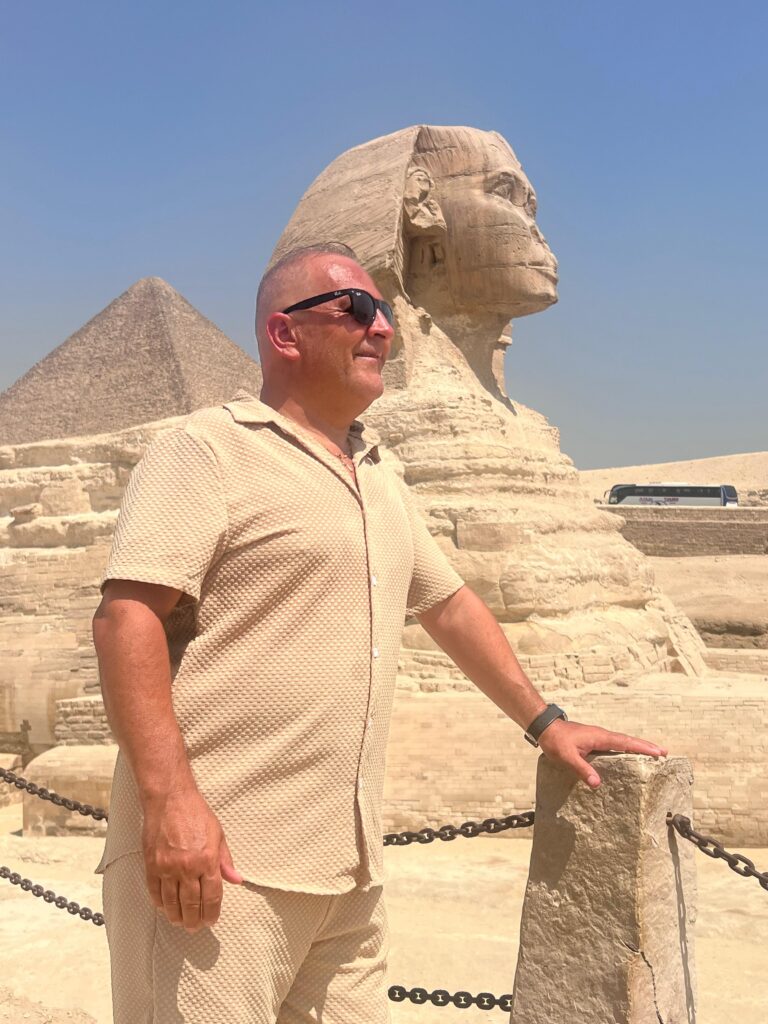
A Pyramids-View Lunch — Dining With History
After the intellectual and emotional journey through the Egyptian Museum, it is time to refuel and relax. One of the most memorable aspects of the day trip to Cairo from El Gouna by plane is enjoying a delicious Egyptian lunch with a direct view of the Great Pyramids of Giza.
The Setting
Imagine sitting at a restaurant terrace, with freshly baked bread on your table, the scent of grilled kebabs in the air, and in the distance — the ancient pyramids rising against the desert sky. It’s not just a meal; it’s an experience that connects body and soul with the land of the pharaohs.
The Menu
Most tours include an open buffet lunch with a variety of authentic Egyptian dishes. Some of the highlights include:
Grilled chicken or kofta – seasoned with traditional spices.
Koshari – Egypt’s beloved street food made of rice, pasta, lentils, chickpeas, and tomato sauce.
Mahshi (stuffed vegetables) – zucchini, grape leaves, or peppers filled with rice and herbs.
Fresh salads and tahini dips, paired with warm pita bread.
For dessert, basbousa or baklava sweetened with honey and nuts.
Of course, refreshing drinks are available, and travelers often opt for a cool hibiscus juice or fresh mango to beat the Cairo heat.
Dining in the Shadow of Eternity
The highlight is not just the food, but the view. As you enjoy your lunch, you can gaze upon the pyramids that have stood for over 4,500 years. Many visitors pause between bites just to absorb the moment. Guides often remind guests: “Few people in the world get to enjoy a meal with this view.”
The Transition
This lunch serves as both a physical rest and a mental preparation for the second half of the day — exploring the mighty Pyramids of Giza and the Sphinx up close. It is the perfect balance of culture, history, and comfort, making the day trip from El Gouna to Cairo by plane smooth, enjoyable, and deeply memorable.
The Spiritual Legacy of Cairo
Cairo is not only the political and cultural capital of Egypt, but also a spiritual beacon that has attracted believers, philosophers, and mystics for centuries. A day trip from El Gouna to Cairo by plane opens the door to this immense spiritual heritage, allowing visitors to witness the blend of ancient beliefs, Islamic traditions, and Christian faith that coexist harmoniously in the city.
One of the most impressive sites is Coptic Cairo, the heart of Egypt’s Christian community. Here, travelers can visit the Hanging Church (Al-Muallaqa), built on the southern gate of a Roman fortress, one of the oldest churches in Egypt. Its ornate wooden screen, icons, and peaceful atmosphere make it a spiritual gem. Close by is the Cave Church of St. Sergius and Bacchus, traditionally believed to be the place where the Holy Family sought refuge during their flight into Egypt. Such locations give profound meaning to travelers who seek more than just history — they offer a spiritual connection to the past.
Equally fascinating is Islamic Cairo, with mosques like the Mosque of Ibn Tulun, dating back to the 9th century, or the Mosque-Madrassa of Sultan Hassan, often regarded as a masterpiece of Islamic architecture. Standing inside these vast spaces with their geometric precision, carved stonework, and soaring minarets, one can feel the deep devotion that shaped Cairo’s skyline.
Even for those who do not practice a specific religion, the spirituality of Cairo can be felt in the rhythm of the call to prayer, the warm hospitality of locals, and the way history and faith are woven into the city’s very fabric. For many travelers, this part of the day trip is transformative — adding a deeper layer of meaning to their Egyptian adventure.
Cairo by Night – A Different Perspective
By the time the day’s main sightseeing is complete, most visitors will have had their fill of pyramids, museums, mosques, and markets. Yet Cairo has one more secret for those who linger a little longer before catching the evening flight back to El Gouna: its nighttime magic.
As the sun sets, the bustling streets take on a different energy. Cafés along the Nile Corniche glow with warm light, families gather for meals, and the city’s famous bridges shimmer with reflections on the water. Taking a felucca ride on the Nile at sunset is a highly recommended way to end the day. The gentle breeze, the sound of water lapping against the boat, and the silhouette of Cairo’s skyline create a moment of serenity that contrasts beautifully with the busy daytime tours.
For those who enjoy culture and entertainment, the Sound and Light Show at the Pyramids of Giza is another unforgettable option. Narrated with dramatic music and colorful projections, the pyramids and the Sphinx are brought to life through stories of ancient kings and queens. Even if you visited them earlier in the day, seeing them illuminated against the desert sky is a breathtaking finale.
Alternatively, a stroll through Downtown Cairo offers the chance to admire the city’s Belle Époque architecture, grab a coffee at one of the historic cafés, or simply people-watch as Cairo comes alive at night. For food lovers, sampling Egyptian delicacies like koshari, falafel, or grilled kebabs at a local restaurant makes for a perfect dinner before returning to the airport.
By the time you board your plane back to El Gouna, Cairo by night will leave you with a final impression: a city that never sleeps, constantly evolving yet always carrying the weight of its extraordinary past. This after-dark perspective completes the day trip experience, ensuring travelers return not just with photographs, but with stories and emotions that linger long after they are home.
The Spirit of the Nile – Experiencing Cairo’s Soul
Cairo is not only about its ancient pyramids and museums—it is also deeply tied to the River Nile, the lifeblood of Egypt for millennia. During your day trip to Cairo from El Gouna by plane, you may catch glimpses of this majestic river while traveling through the city. The Nile flows gracefully, dividing Cairo into eastern and western banks, and it has always been central to Egypt’s existence.
Many visitors choose to add a short Nile felucca ride or motorboat trip in Cairo, especially after visiting the Pyramids. These traditional boats, with their white sails and gentle movements, allow you to see Cairo from a different perspective. Floating on the Nile is both relaxing and symbolic—it connects you with the very heart of Egypt’s culture and history.
Whether you take this boat ride or simply admire the river while passing bridges, the Nile adds a poetic and soulful dimension to your day trip to Cairo from El Gouna by plane. It is a reminder that Egypt’s greatness is not only built on stone monuments but also on the timeless gift of the Nile.
Shopping in Cairo – Souvenirs to Remember
No day trip to Cairo from El Gouna by plane would be complete without exploring Cairo’s vibrant bazaars and markets. After sightseeing, your guide may take you to Khan El Khalili Bazaar, one of the oldest and most famous markets in the Middle East, dating back to the 14th century.
Here, the streets are alive with colorful shops selling everything from handmade jewelry, papyrus paintings, alabaster statues, leather goods, perfumes, Egyptian cotton scarves, and spices. The atmosphere is enchanting—you hear merchants calling out their offers, the smell of incense fills the air, and every corner has something fascinating to discover.
Shopping in Cairo is not only about buying souvenirs—it is also about experiencing the local culture. Bargaining is part of the fun, and your guide will usually help you negotiate for fair prices. Each item carries a story: a papyrus painting depicting the gods of Ancient Egypt, a silver cartouche with your name engraved in hieroglyphics, or a bottle of authentic Egyptian perfume inspired by the pharaohs.
Bringing back a piece of Cairo makes your journey unforgettable. When you return to El Gouna, every time you see your souvenir, it will remind you of the incredible day trip to Cairo from El Gouna by plane, filled with history, culture, and discovery.
The Cairo Museum Treasures – A Journey Through Egypt’s Soul
The Egyptian Museum in Cairo is not just a building—it is the soul of Egypt, a vault where the country’s millennia of history breathe. For travelers coming on a day trip to Cairo from El Gouna by plane, this museum is a must, and it often becomes the highlight of the entire tour.
The museum is located in Tahrir Square, right at the heart of Cairo, and as you step through its grand entrance, you are instantly transported into another world. The collection spans over 120,000 artifacts, showcasing everything from tiny everyday objects used by ancient Egyptians to colossal statues that once adorned the temples of pharaohs.
Highlights of the Museum Visit
The Golden Mask of Tutankhamun – Perhaps the most famous artifact in the entire museum, this mask radiates mystery and beauty. It’s made of solid gold inlaid with lapis lazuli and semi-precious stones, perfectly preserving the face of the boy king. Standing before it, many travelers describe the experience as “otherworldly.”
The Royal Mummies Room – In a dimly lit hall, visitors encounter the real faces of Egypt’s greatest rulers. Ramses II, Seti I, Hatshepsut—their bodies, preserved for thousands of years, lie silently, exuding both majesty and fragility.
Statues of Amenhotep III and Tiye – These colossal statues show the might and elegance of one of Egypt’s greatest pharaohs and his queen, a true power couple of the ancient world.
Jewelry and Daily Life Artifacts – Golden bracelets, delicate combs, toys, papyrus scrolls—all whispering stories of people who lived and loved thousands of years ago.
The Emotional Experience
Visitors often describe their time at the museum as moving and humbling. To see the treasures that once lay in tombs, untouched for centuries, is to stand face to face with eternity.
For guests flying in from El Gouna, the museum visit is carefully timed to allow them to explore the most significant collections without being rushed. Professional Egyptologists guide each step, explaining the symbolism, the historical context, and the myths that surround the artifacts.
A Walk Through Old Cairo – Where Faiths and Cultures Meet
After exploring Egypt’s pharaonic past in the museum, the journey continues into Old Cairo, a place where time seems to stand still and where the story of Egypt’s multi-religious heritage unfolds.
Old Cairo is one of the most spiritual and culturally rich districts in the city. Here, narrow alleys wind through ancient churches, mosques, and synagogues, standing side by side as a testament to Egypt’s centuries of coexistence and tolerance.
Key Stops in Old Cairo
The Hanging Church (El Muallaqa) – Suspended above the Roman fortress of Babylon, this Coptic Christian church is one of the oldest in Egypt. Its icons, chandeliers, and carved wooden ceiling immerse visitors in a sacred atmosphere.
Ben Ezra Synagogue – A place of profound history, this synagogue is where the famous Cairo Geniza was discovered, a treasure trove of ancient Jewish manuscripts that shed light on medieval life in the region.
The Mosque of Amr ibn al-As – Founded in 642 AD, this is the very first mosque built in Egypt and Africa. Its serene courtyards and columns echo with centuries of devotion.
A Cultural Mosaic
Walking through Old Cairo is like leafing through a living history book. You move from a Christian sanctuary to a Jewish synagogue, and then into a mosque—all within a few hundred meters. This rare blend of religious heritage makes Old Cairo a symbol of Egypt’s unique place as a crossroads of civilizations.
Atmosphere and Local Life
Apart from its holy sites, Old Cairo is alive with activity. Street vendors sell incense, rosaries, handmade crafts, and snacks. Families stroll through the district, and the scent of fresh bread lingers in the air. Visitors from El Gouna often find this part of Cairo especially enriching, as it shows the continuity of Egyptian culture beyond the grandeur of the pyramids and pharaohs.

Reflections by the Nile – The Soul of Cairo
After a day filled with history, mystery, and exploration, travelers on the day trip to Cairo from El Gouna by plane often find themselves drawn to the Nile River, Egypt’s lifeline for thousands of years. Standing on its banks or gliding along its waters in a traditional felucca boat, you immediately understand why the ancients revered this river as sacred. The Nile is not just water—it is memory, legacy, and survival.
Many flight tours from El Gouna to Cairo include an optional Nile boat ride. This short but magical journey offers a different perspective of the capital. Away from the bustling traffic and honking horns, the river provides a calming contrast, where gentle breezes kiss your face and the skyline reflects on the rippling waters.
As your boat drifts along, you see both worlds of Cairo unfold:
The timeless side – fishermen casting nets, domes of old mosques, and minarets echoing the call to prayer.
The modern side – skyscrapers, luxury hotels, and bridges buzzing with life.
This mix of old and new perfectly symbolizes the spirit of Cairo. While the pyramids remind you of eternity, the Nile whispers of continuity—always flowing, always nourishing.
Your guide may share stories of how pharaohs depended on the flooding of the Nile to ensure fertility of the land, and how ancient Egyptians believed the river was a gift from the gods. Looking at the waters today, shimmering under the sun, you cannot help but feel connected to those ancient souls who once stood at the same riverbanks.
For many travelers, this quiet reflection along the Nile becomes one of the most emotional highlights of their day trip to Cairo from El Gouna by plane. It’s a moment of gratitude—for history, for life, and for the chance to witness Egypt’s eternal beauty.
Shopping, Souvenirs, and the Cairo Bazaars
No journey to Cairo is complete without a dive into its bustling bazaars and traditional markets, and your El Gouna to Cairo flight tour often includes free time to experience this lively side of Egyptian culture.
One of the most famous spots is the Khan El Khalili Bazaar, located in the heart of Islamic Cairo. This centuries-old marketplace is a maze of narrow alleys filled with shops, stalls, and workshops, each bursting with colors, scents, and sounds. Here, you don’t just shop—you step back in time.
What You Can Find in Cairo’s Markets:
Handmade jewelry inspired by pharaonic designs, often featuring scarabs, ankhs, and Horus eyes.
Alabaster and stone carvings, small replicas of the pyramids and Sphinx.
Perfume oils and spices that fill the air with exotic aromas.
Papyrus paintings depicting scenes from ancient tombs and temples.
Traditional clothing like galabeyas, scarves, and embroidered fabrics.
The beauty of shopping in Cairo is not just in the items you buy, but in the experience of bargaining. Egyptian shopkeepers love negotiation—it’s part of the fun. Your guide will often give tips on how to haggle respectfully, ensuring you get a fair deal while enjoying the lively exchange.
Beyond Shopping: The Atmosphere of the Bazaar
Walking through the bazaar, you are immersed in a sensory explosion. The vibrant chatter of merchants, the clinking of copper lanterns, the sparkle of silverware, and the rich smell of freshly ground coffee beans all mix together to create a unique memory.
This is also a chance to interact with Cairenes (locals of Cairo) in a more personal way. Many merchants are warm and welcoming, eager to share stories of their crafts or offer you a taste of Egyptian tea while you browse.
By the time you leave, carrying your chosen souvenirs, you don’t just take home objects—you take home a piece of Cairo’s soul. Each item becomes a reminder of your day trip to Cairo from El Gouna by plane, holding within it the laughter, bargaining, and warmth of Egypt’s people.
Scandinavian Languages in the Age of Globalization
The 21st century has brought about a rapid transformation in communication, commerce, and culture. Globalization has not only connected nations economically but also linguistically. English, often regarded as the global lingua franca, has deeply influenced the Scandinavian languages—Danish, Norwegian, and Swedish. This chapter explores the ways globalization has reshaped these languages, while also highlighting the resilience and adaptability of Scandinavian linguistic traditions.
1. English as a Global Influence
English dominates international business, technology, science, and entertainment. Scandinavia, known for its high English proficiency, has absorbed thousands of English loanwords. From everyday slang to technical jargon, English expressions have become commonplace in Scandinavian speech. For instance:
In Swedish: maila (to email), dejta (to date), streama (to stream).
In Danish: cool, weekend, app.
In Norwegian: chatte (to chat), game (to play video games).
Interestingly, these words are often “Scandinavized” to fit local grammar and pronunciation, showing how global and local forces merge.
2. Technology and Digital Communication
The rise of the internet, smartphones, and social media has accelerated linguistic borrowing. Younger generations often blend English with their native languages, a phenomenon sometimes referred to as Swenglish (Swedish-English), Danglish (Danish-English), and Norwenglish (Norwegian-English).
For example, a Danish teenager might write:
“Jeg skal lige checke min app og så gamer vi bagefter”
(“I just need to check my app and then we’ll game after.”)
This fluid switching illustrates the multilingual environment of the digital age.
3. The Global Music and Film Industry
Scandinavia has produced internationally renowned musicians, actors, and filmmakers. While many create in English to reach a global audience, they also influence their native tongues. Pop culture imports—from Hollywood films to K-pop—also leave their mark on Scandinavian slang and vocabulary.
4. Migration and Multiculturalism
Globalization has brought increased immigration to Scandinavia. With it comes linguistic diversity: Arabic, Somali, Kurdish, Farsi, and other languages are now part of Scandinavian urban life. This diversity enriches Scandinavian languages, introducing new expressions, accents, and speech patterns. Youth culture in cities like Stockholm, Oslo, and Copenhagen reflects a hybrid linguistic identity, often mixing Scandinavian grammar with foreign words.
5. Balancing Global and Local
While globalization could threaten linguistic uniqueness, Scandinavia has embraced bilingualism. Schools ensure strong English skills but also prioritize mother tongue education. Scandinavian languages remain central in literature, governance, and national identity. This balance between local tradition and global communication is key to their survival.
Future Prospects for Scandinavian Languages
What lies ahead for Danish, Norwegian, and Swedish? Will they thrive, fade, or merge into a single pan-Scandinavian dialect? This chapter looks at possible future scenarios for Scandinavian languages in light of globalization, digitalization, and cultural change.
1. Technological Integration
Advancements in Artificial Intelligence, machine translation, and voice recognition systems increasingly support smaller languages. Platforms like Google Translate, ChatGPT, and language-learning apps now include Scandinavian languages, ensuring digital presence and accessibility. As technology improves, speakers will continue to use their native tongues confidently in global communication.
2. Nordic Cooperation and Language Unity
The Scandinavian countries already share strong cultural and political ties. Mutual intelligibility between their languages could strengthen in the future, perhaps leading to efforts toward a standardized “Nordic language” for easier communication. While unlikely to replace national languages, such initiatives could enhance cultural cohesion.
3. Preservation Efforts
Governments and cultural organizations continue to invest in preserving their languages:
Denmark emphasizes cultural heritage in schools.
Norway protects both Bokmål and Nynorsk equally.
Sweden actively supports Swedish in law, media, and science.
These policies ensure Scandinavian languages remain strong in official domains.
4. Youth and Linguistic Identity
Younger generations will shape the future of Scandinavian languages. If they continue blending English with native speech, a more hybrid form of Scandinavian may emerge. However, identity and pride in native languages suggest that complete linguistic assimilation into English is unlikely.
5. Challenges Ahead
Dominance of English: May erode vocabulary in specialized fields.
Immigration pressures: Could lead to greater linguistic fragmentation in urban centers.
Global competition: Media and tech industries heavily dominated by English.
Despite these challenges, Scandinavian languages are well-positioned for survival thanks to high literacy rates, strong educational systems, and cultural pride.
6. A Vision for the Future
It is most likely that Scandinavian languages will continue to evolve organically, borrowing from global trends while maintaining a distinctly Nordic identity. They may sound more Anglicized in the future, yet they will still serve as vital carriers of Scandinavian culture, history, and identity.
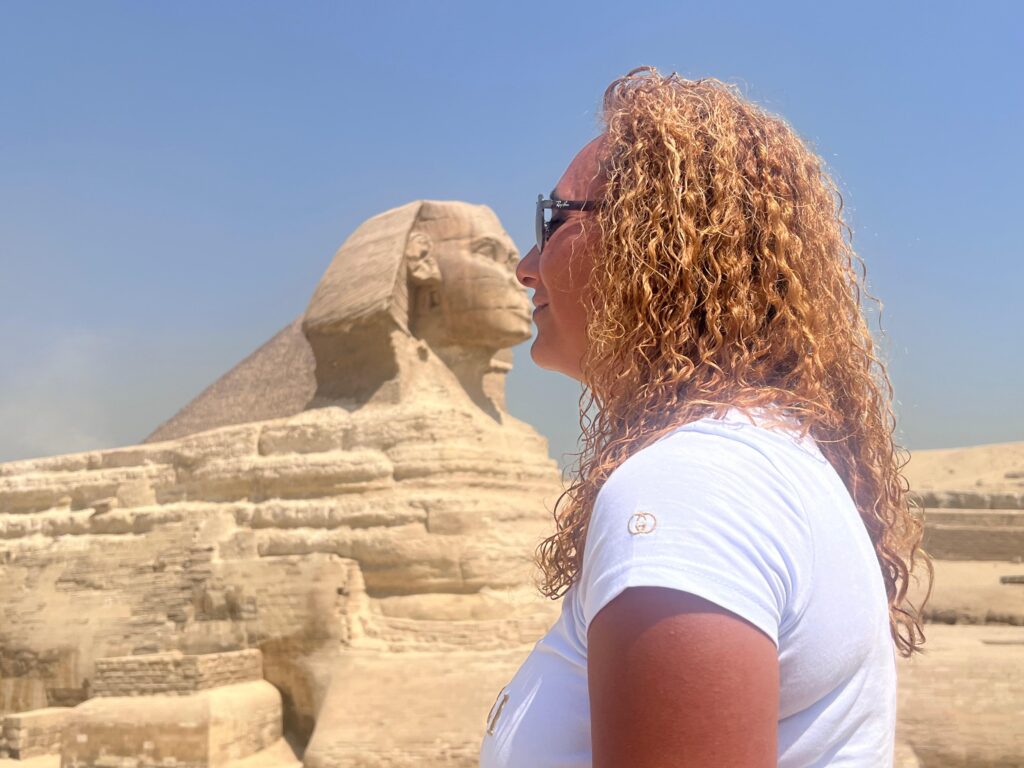
Customer Support:
- Email: [email protected]
- 24/7 live chat available on our website for immediate assistance.
- Offecial Website www.Hurghadatogo.com
- WhatsApp: 01009255585

